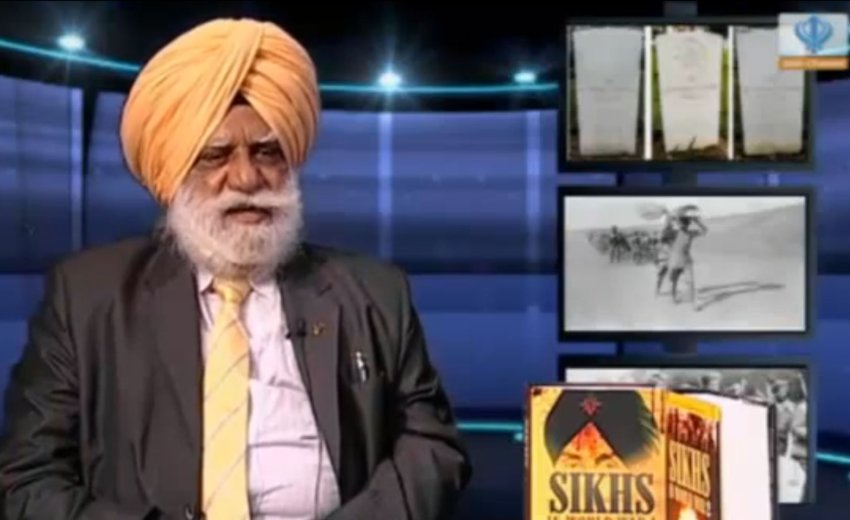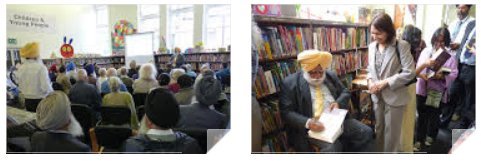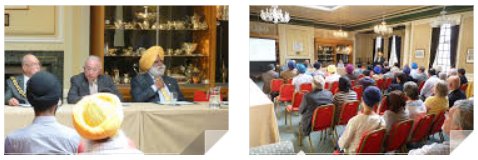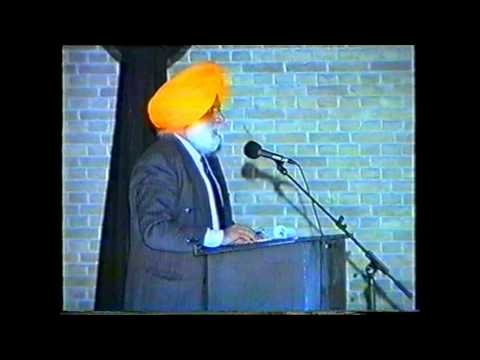 August 11th 2014, Leicester Central Library, Leicester, UK.: Today, we have gathered here to remember the great sacrifices of Sikh soldiers of World War I & II. It is matter of pride for us to be in the City Town Hall of Leicester who offered 19 Battalions of Royal Leicestershire Regiment, also known as "The Tigers "in the 1st World to fight in France, Flanders-Belgium, and Mesopotamia and in the Palestine. Sikhs and Royal Leicestershire fought many battles together especially the Battle of Neuve Chapelle France from 13 March till 15 March 1915. Royal Leicestershire Regiment had lost approximately 6,000 young soldiers from Leicester and surrounding areas in the four years of war. Like the Sikh soldiers, they have given their lives for the freedom of mankind and for our better future. Thus we, as the Sikh Nation, has a very strong relation with the people of Britain and the Leicester City.
August 11th 2014, Leicester Central Library, Leicester, UK.: Today, we have gathered here to remember the great sacrifices of Sikh soldiers of World War I & II. It is matter of pride for us to be in the City Town Hall of Leicester who offered 19 Battalions of Royal Leicestershire Regiment, also known as "The Tigers "in the 1st World to fight in France, Flanders-Belgium, and Mesopotamia and in the Palestine. Sikhs and Royal Leicestershire fought many battles together especially the Battle of Neuve Chapelle France from 13 March till 15 March 1915. Royal Leicestershire Regiment had lost approximately 6,000 young soldiers from Leicester and surrounding areas in the four years of war. Like the Sikh soldiers, they have given their lives for the freedom of mankind and for our better future. Thus we, as the Sikh Nation, has a very strong relation with the people of Britain and the Leicester City.
We are proud that Sikh Nation has helped the international Community twice in the 20th Century by fighting alongside with the allied forces of Great Britain, USA, France, Belgium, Canada, Australia and other Countries to preserve peace and freedom in the world. They have died in large numbers for all of us for our freedom and better future. We now live with dignity, honor and pride. Their supreme sacrifice is in accordance with the teachings of Sikh religion.
Sikh soldiers of 15th Sikh regiment ( Multan ) landed in Marseilles -France on the 26th of September 1914 for the 1st time.
This year 2014 is being remembered as the arrivals of the Sikhs in Europe as well as the year of the beginning of World War I. Also the Sikhs had their first action against European country that is Germany on 22 October 1914 near Hollebeke - Belgium where a Sikh Monument stands since 1999, built by the City of Ieper and inaugurated by Panj Piaras to mark the 3rd Century of the birth of the Khalsa. That means these historical event are being celebrated throughout the world and in Europe by the Sikhs and Europeans together.
The forces of British India played a major role in both World Wars. Nearly 1,700,000 men and women of the Commonwealth including some 169,700 from the forces of undivided British India died in the 1914-18 and 1939-45 Wars.
In the first World War, the strength of the British Indian Army rose to 1,6 million in 1918 with Sikhs as the major force, nearly 33 %.
Sikhs have fought in 4 Continents in World War 1
Europe: in France, Belgium, Germany, Greece, Italy - Malta, Romania and some graves of the Sikhs (Pilots and wounded) are also in the United Kingdom.
Africa: Kenya and Tanzania.
Asia: Hong Kong, India and Turkey.
Middle East: Egypt, Iran, Iraq, Israel, Lebanon, Palestine, Syria.
In Europe during WW-1, it fought in Belgium-Flanders at Ypres twice from 22 October 1914 till 31 October 1914 and from 22 April 1915 till 1st of May 1915 and in France at La Bassee, and Neuve Chapelle from 10 to 13 marches 1915, Auber's Ridge, Festubert, Loos 25 September 1915, Givenchy and Somme from July 1916 to November 1916, thus fighting 7 Battles in France and 2 in Belgium.
Record of CWGC is incomplete
Common Wealth War Grave Commission has recorded 8318 + 493 thus 8811 total names of British Indian soldiers , died in France and Belgium respectively on the western Front which is very far from the actual fact. My Research reveals the following facts and the figure is much more.
"During World War I on the western Front that is Belgium and France, only in 14 months, the Indian Corps had lost 34,252 men (dead, wounded, ill, or prisoner of war mostly the Sikhs.)"
"The losses of the 57th Wilde's Rifles and the 129th Baluchis were great during the last two days of October 1914 (during the 1st battle of Ieper). The Wilde's Rifles lost 300 out of 750, the Baluchis had 240 men killed, wounded or taken as POWs.
"The Menon Gate in Ieper has the name of 15 casualties from the 47 Sikh Regiment while alone on 27 April 1915 (during the 2nd Battle of Ieper) out of 444 men 348 did not come back. They are nowhere else commemorated. Between 24th April and 1st May 1915, the Lahore Division had lost 3,889 men, or 30 % of the troops it had employed."
These casualties of British Indian soldiers are nowhere commemorated in Belgium.
I will mention here 3 letters of Sikh soldiers written to their relatives from the Battlefield to the Punjab.
1)* A Sikh soldier wrote to his uncle in Jallandhar (Punjab),
"Thousands and hundreds of thousands of soldiers have lost their lives. If you go on the fields of battle you will see corpses piled upon corpses so that there is no place to place or put hand or foot. Men have died from the stench. No one has any hope of survival, for back to Punjab will go only those who have lost a leg or an arm or an eye. The whole world has been brought to destruction."
2) *The spirit of the Khalsa can be felt from a poem (295) written in (Gurmukhi) by Dafadar Nathan Singh (Sikh) to Sowar Paran? Singh of State Cavalry, Jind State, Punjab on 18th April 1916 from 2nd Lancers, France.
The Sikh roars like a lion on the field of battle,
And yields up his life as a sacrifice:
Whoever is fortunate enough to be born a Rajput
Never fears the foe in battle:
He gives up all thought of worldly pleasure,
And dreams only of the battle field:
He who dies on the field of battle,
His name never dies, but lives in history:
He who fronts the foe boldly in battle,
Has God for his protection: Once a Sikh takes the sword in Hand,
He has only one aim: victory!
3) *Sikh soldier's love and regards for the family of Maharaja Ranjit Singh is well shown in the letter of Kartar Singh (Sikh, 15th Sikhs) to Gurdit Singh (Raswind, Punjab) from Milford -on -Sea on 24th February 1916 via letter no (253) (Gurmukhi)
"And my friend, this is the photo of our King's granddaughter - he who was King of the Sikhs, Ranjit Singh. She has distributed her photo amongst Sikh brethren at the depot (Milford) on the evening of the 23rd February at five o' clock." (Written on the back of a photo of a lady friend, signed Sophia A. Duleep Singh 1916) Omissi, David, Indian voices of the Great War. Soldier's letters, 1914-18, London, 1999.
There are 15,519 Burial place ( Smaads ) of the British Indian soldiers and 64,963 are commemorated by Memorial thus total of 80,482 have died in Ist World War (1914-18) according to the register of Common Wealth War Grave Commission.
Basra Memorial, Iraq has the largest 33,367 British Indian soldiers Commemoration by Memorial followed by Delhi Memorial, India Gate (12,321), Neuve Chapelle Memorial, France (5015)
Amara (Left Bank) Indian War Cemetery, Iraq has the largest Burials (Smaads) of British Indian soldiers (5000) followed by Baghdad (North Gate) War Cemetery (2513) and Mazargues War Cemetery, France (1002)
Total died in 1st World War (1914-1918) = 80,482. This is according to the register of CWGC record.
But first of all I need to give a short introduction on the British Indian army. The Indian army was organized in a similar way as the British army but there were some significant differences. First of all, it had its own military law. Secondly, in the British Indian Army a regiment equals a battalion, although there are some exceptions to this rule. This means, for instance, that the 15th Sikhs does not mean the 15th battalion of the Sikhs regiment, but the 15th regiment!
A British Indian infantry division was composed of three brigades with four battalions (after the battle of Neuve-Chapelle in April 1915, five battalions). One of these four battalions was British, among other reasons as an element of controlling the Indian troops. An British Indian battalion consisted in theory of 13 officers and 750 rank and file - less than its British counterpart.
There were ethnic mixed battalions, such as the 57th Wilde's Rifles (8 companies, of which 2 Sikhs, 2 Dogra Sikhs, 2 Pathans, 2 Punjabi Muslims) and ethnic homogeneous battalions, such as the 47th Sikhs (only Sikhs). It was a clear policy of the British to ensure a spirit of competition between the different peoples. It is common knowledge that Sikhs and Gurkhas were considered to be martial races.
There were two types of officers, British and Indian with the British always commanding the Indian. The higher ranks had the same names as in the British army, but there were some specific ranks such as subadar major (cf major), subadar (cf captain) & jemadar (cf lieutenant - commanding a platoon).
At the level of the NCOs, Indian terms were used: havildar major (sergeant-major), havildar naik (corporal) and lance naik. A private was a sepoy. The cavalry had its own ranks such as risaldar (captain), woordie-major (Indian adjutant), kot daffadar (sergeant major) etc. A trooper was a sowar. It is also important to emphasise the very particular relationship that existed between the British officers, their Indian NCOs and the rank and file. The British officers did speak the local languages and the relationship towards the Indian troops they were commanding is best described as paternalistic. There are numerous accounts of mutual respect from the officers towards the Indians and vice versa.
The story of the British Indian army on the Western Front starts on 6th August 1914. On that day, the War Council asks the Indian government to send two infantry divisions and a cavalry brigade to Egypt. The divisions chosen were the Lahore and the Meerut Divisions, later followed by the Secunderabad Cavalry Brigade which together formed the Indian Army Corps.
On 27th August the British Government decides to send the Indian divisions to France in order to reinforce the B.E.F. that had recently been forced to withdraw after Mons. Meanwhile, the Lahore Division was already on its way to the front. Its new destination was Marseilles, where it arrived by the end of September.
In Belgium :
On 22nd October 1914, the Ferozepore Brigade arrives in the "new-born" Ypres Salient. They are sent to the trenches between Hollebeke in the north and Messines in the south. That was 8 km long. At Hollebeke, 1st action took place against Germany and 57th Wilde's Rifles (Dera Ismail Khan): 2 Sikhs, 2 Dogra Sikhs, 2 Punjabi Moslims, 2 Pathans.
To mark this historical event, there stands now a "Monument of the Sikhs", built by City of Ieper and inaugurated by Panj Piaras on 3rd of April 1999 to remember the 3rd Century of the revelation of the Khalsa by Guru Gobind Singh Ji in April 1699.
Prominent Sikh leaders from the whole world attended this event including S. Inder Singh Jamu - Mayor of London Borough of Barking & Dagenham, S.Tersem Singh Bhogal - Mayor of London Borough of Waltham Forest, Janab Abdul Karim Sheiklh - Mayor of London Borough of Newham and many political leaders of UK. Family of Maharaja Duleep Singh S. Beant Singh Sandhawalia also came from Amritsar - Punjab to attend.
I will describe here battle of Messines where Sikhs got martyrdom rather to surrender.
On 30th October, after a heavy initial bombardment, the Germans attacked the Indian troops from the ridge of the Zandvoorde. The Indian and British troops were by far in the minority, had little ammunition and sparse artillery support, so it was obvious that it would be very hard to stand to. Two companies of the 57th Wilde's Rifles withdrew to Messines, where they were dispersed in the streets of the town. There was one officer there to point out the direction of HQ in Wijtschate, but some got lost and arrived in Kemmel, some 2.5 miles wrong! Other units of the 57th Wilde's Rifles were also forced to withdraw. Thus, a Sikh company had to take a new position in the neighborhood of a battery near the mill east of the Wijtschate-Messines Road.
Another company did not get the order to withdraw as all means of communication were cut or lost. When the message finally came through, it was too late as they were completely surrounded by German troops. The Baluchis too, in the neighborhood of the chateau on the other side of the canal and the railway, had very difficult times when standing.
The battle raged on until the next day. After a bombardment that lasted the whole night, Messines was stormed by nine German battalions. They overwhelmed the trenches of the 57th Wilde's Rifles and many units of this battalion were literally annihilated. Jemadar Ram Singh was the only survivor of his platoon.
Another Sikh, jemadar Kapur Singh, kept on fighting until everyone else was out of action, except for one wounded sepoy. As he did not want to surrender, he committed suicide with his last bullet. All British officers of the 57th Wilde's Rifles, present on this part of the front, were killed. On that same day 31st October 1914 in the vicinity of Hollebeke, the action took place for which, some months later, Khudadad Khan of the 129th Baluchis was going to be the first Indian to be awarded the Victoria Cross.
26 April 1915, Chemical Gas was used against the Sikhs, British, French and Moroccans.
Now the British, together with the French troops, wanted to make a counter-attack in order to force the Germans to withdraw from this new position. The 47th Sikhs, which was in the first line of attack, lost 348 men from a total of 444, or 78 % of the battalion! It was almost annihilated. . Among the British Indian troops the warning was spread that, in case of the use of gas, a handkerchief (or the pagri-dastaar) was to be placed over the mouth. It was recommended to soak the handkerchief (or pagri) in urine. In total the attack resulted in almost 2000 casualties in the two brigades.
During this attack, Corporal Issy Smith of the 1st Manchesters, which belonged to the Jullundur Brigade won a Victoria Cross. Amidst heavy shelling and continuous gunfire, he had ceaselessly evacuated the wounded.
Also Mula Singh and Rur Singh of the 47th Sikhs distinguished themselves by saving many lives. Bhan Singh, a Sikh of the 57th Wilde's Rifles, was wounded in the face early during the attack. Nevertheless, he stayed near his officer, Captain Banks. When Banks fell, Bhan Singh thought just of one thing, bringing Banks back, dead or alive. Weakened as he was, he stumbled on with Banks' body under heavy fire until he was completely exhausted. However, he did not return without first saving Banks' personal belongings.
But let's get back to the night of 26th -27th April 1915 when the chlorine gas was to be smelt the whole night. Only late that night could the remnants of Major Deacon's party be relieved. The Ferozepore and Jullundur Brigades were withdrawn to the Brieke while the Sirhind Brigade replaced them in the first line. Men of the 34th Sikh Pioneers did try to consolidate the difficult position when Major Deacon did manage to keep a stand.
Later, two men of that unit, sappers Jai Singh and Gujar Singh, were awarded the Indian Distinguished Service Medal because they had established communication lines under constant fire. On the three following days, the attack was repeated again and again, but never with any result for the North Africans, British and Indians. The Germans opened the gas cylinders time and again and, on 27th April, the first "gas masks" were issued. Shortly after 1 p.m. on 27th April, the Moroccans, the Sirhind and the Ferozepore Brigades went again in attack, now supported by the Canadian artillery.
Regiment Informations:
9th Bhopal Infantry (-): 2 Sikhs, 2 Rajputs, 2 Moslims, 2 Brahmins
15th Ludhiana Sikhs (Multan): 8 Sikhs
34th Sikh Pioneers (Ambala): 8 Mazbi en Ramdasia Sikhs
40th Pathans (Sialkot): 2 Orakzais, 1 Afridis, 1 Yusufzais, 2 Dogras, 2 Punjabi Moslims
47th Sikhs (Rawalpindi): 8 Sikhs
57th Wilde's Rifles (Dera Ismail Khan): 2 Sikhs, 2 Dogras, 2 Punjabi Moslims, 2 Pathans
59th Scinde Rifles (Kohat): 3 Pathans, 2 Sikhs, 1 Punjabi Moslims, 2 Dogras
125th Napier's Rifles (Nasirabad): 4 Rajputana Jats, 2 Rajputana Rajputs, 2 Punjabi Moslims
129th D. of C.'s Own Baluchis (Karachi): 2 Punjabi Moslims, 3 Mahsuds, 3 other Pathans
15th Lancers (Cureton Multanis): 4 eskadrons Multani Pathans and Moslims from the Dejarat and Cis-Indus.
Neuve Chappelle, France.
After the bloody battle of Neuve Chapelle, France (10 till 13 March 1915) the Sikh Regiments had lost eighty percent of their men and three regiments stood at only sixteen percent of its original composition.
On October 7, 1927 the Secretary of State for India Earl of Birkenhead, unveiled the noble Memorial which has been erected by the Imperial War Graves Commission at Neuve Chapelle in France to the memory of all Indian soldiers who fell on the Western Front in the Great War of 1914-1918.
Speaking on the occasion in French, Marshal Foch of the French Army who signed the Armistice document at 05:05 hours on 11 November 1918 with Matthias Erzberger, the leader of the German delegation and one of the new German leaders, stated frankly,
"The Indian Troops were thus among the first to show the way to a victorious offensive. It is only right that a Memorial should perpetuate the glorious memory of officers, non -commissioned officers and men of the British Indian Army at the very spot where later on a general attack by the Allied troops was to bring the decisive victory in sight."
Turning to the British Indian Contingent, he bade them:
"Return to your home in the distant, sun bathed East and proclaim how your countrymen drenched with their blood the cold northern land of France and Flanders, how they delivered it by their ardent spirit from the firm grip of a determined enemy ; tell all India that we shall watch their graves with the devotion due to all our dead. We will cherish above all the memory of their example. They showed us the way, they made the first steps towards the final victory."
it marks the gratitude of the great French nation which was defended from German invasion by the supreme sacrifices of the British Indian Army in France. It marks the French gratitude of the French people who built it on their soil. For the ceremony, special units including Sikhs who engaged in the actual war were brought from India with Maharaja of Kapurthala as a special guest.
Lieutenant General Sir James Wilcox, Commander of the Indian Corps : WW1, France & Flanders.
'It was the dark days of 1914 when our men had to face mortars, hand grenades, high explosive shells with which they themselves were not provided. They could reply only with their valour, their rifles and two machine guns per battalion. And yet they did it.'
Lt.General Sir Reginald Savory K.G.T., C.B., D.S.O., M.C. states in a letter to Mrs.G.Scott, Scientific Section, House of Commons Library:
"I have known Sikhs to pick bullets out of their turbans during and after battle. In fact the turban absorbs the shock of a bullet possibly rather better than a tin helmet. If the turban is properly tied, it will also form an effective buffer too, for instance from a toss from a motor bicycle.
During World War 1, when the steel helmet was first introduced, we British Officers of Sikh Regiments tried to persuade our men to wear them, but they steadfastly refused, and have done so ever since."
Total died in 2nd World War (1939-1945) = 89,218
Total who died in both World Wars are: 80,482 + 89,218 = 1,69,700. Besides this, more than quarter of a million were wounded, ill, or prisoners of war.This are according to the register of CWGC record.
In the words of General Sir Frank Messervy, K.C.S.I., K.B.E., C.B., D.S.O. "Finally we that live on can never forget those comrades who, in giving their lives, gave so much that are great and good to the story of the Sikh Regiment. No living glory can transcend that of their supreme sacrifice. May they rest in peace. In the last Two World Wars 83,005 turban wearing Sikh soldiers were killed and 109,045 were wounded. They all died or were wounded for the freedom of Britain and the World, enduring shellfire with no other protection but the turban, the symbol of their faith."
Sir Winston Churchill paid tribute to the contribution of the brave Sikh soldiers by saying ' We are today able to live with honor, dignity and independence. In the war, they fought and died for us, wearing the turbans'.
- Total Military persons 10 million and civilians 7 million have died in WW I.
 |
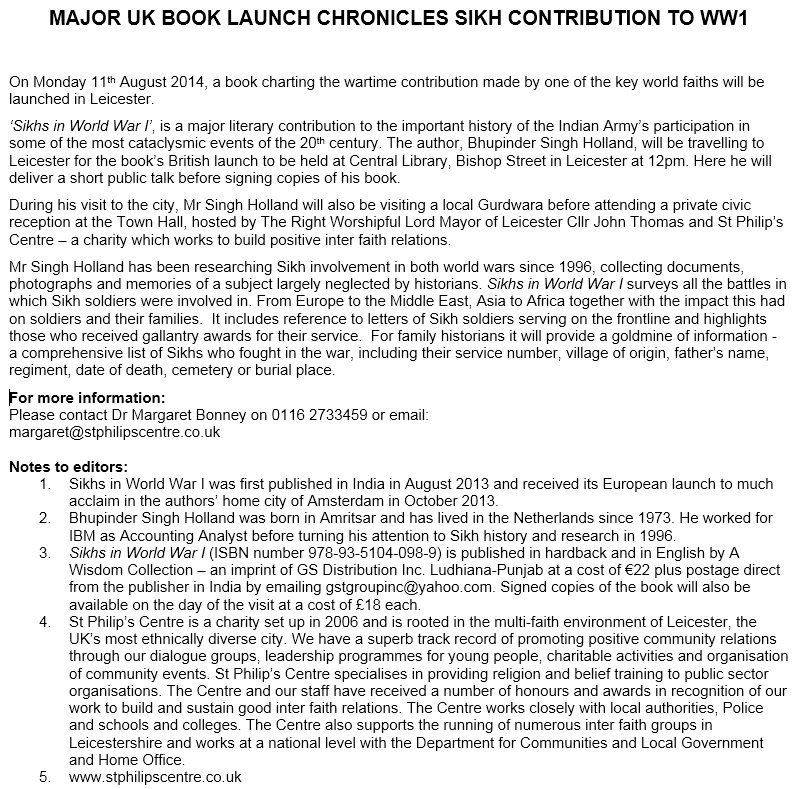 |
|
|
100 years of World War I - Contribution of the Sikhs, Sikh Channel 24-08-2014 |
|
Special Interview - Sikhs in World War I - Sikh Channel UK on 25-08-2014 |
---------------------------------
Related Article:
http://www.sikhnet.com/news/sikhs-world-war-i-launched-ieper
